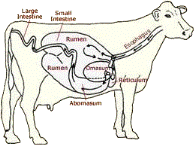Gut Function Initiative

Samodha C. Fernando Publications
Document Type
Article
Date of this Version
2010
Citation
APPLIED AND ENVIRONMENTAL MICROBIOLOGY, Nov. 2010, p. 7482–7490, Vol. 76, No. 22; doi:10.1128/AEM.00388-10
Abstract
High-grain adaptation programs are widely used with feedlot cattle to balance enhanced growth performance against the risk of acidosis. This adaptation to a high-grain diet from a high-forage diet is known to change the rumen microbial population structure and help establish a stable microbial population within the rumen. Therefore, to evaluate bacterial population dynamics during adaptation to a high-grain diet, 4 ruminally cannulated beef steers were adapted to a high-grain diet using a step-up diet regimen containing grain and hay at ratios of 20:80, 40:60, 60:40, and 80:20. The rumen bacterial populations were evaluated at each stage of the step-up diet after 1 week of adaptation, before the steers were transitioned to the next stage of the diet, using terminal restriction fragment length polymorphism (T-RFLP) analysis, 16S rRNA gene libraries, and quantitative real-time PCR. The T-RFLP analysis displayed a shift in the rumen microbial population structure during the final two stages of the step-up diet. The 16S rRNA gene libraries demonstrated two distinct rumen microbial populations in hay-fed and high-grain-fed animals and detected only 24 common operational taxonomic units out of 398 and 315, respectively. The 16S rRNA gene libraries of hay-fed animals contained a significantly higher number of bacteria belonging to the phylum Fibrobacteres, whereas the 16S rRNA gene libraries of grain-fed animals contained a significantly higher number of bacteria belonging to the phylum Bacteroidetes. Real-time PCR analysis detected significant fold increases in the Megasphaera elsdenii, Streptococcus bovis, Selenomonas ruminantium, and Prevotella bryantii populations during adaptation to the high-concentrate (high-grain) diet, whereas the Butyrivibrio fibrisolvens and Fibrobacter succinogenes populations gradually decreased as the animals were adapted to the high-concentrate diet. This study evaluates the rumen microbial population using several molecular approaches and presents a broader picture of the rumen microbial population structure during adaptation to a high-grain diet from a forage diet.


Comments
Copyright © 2010, American Society for Microbiology. Used by permission.